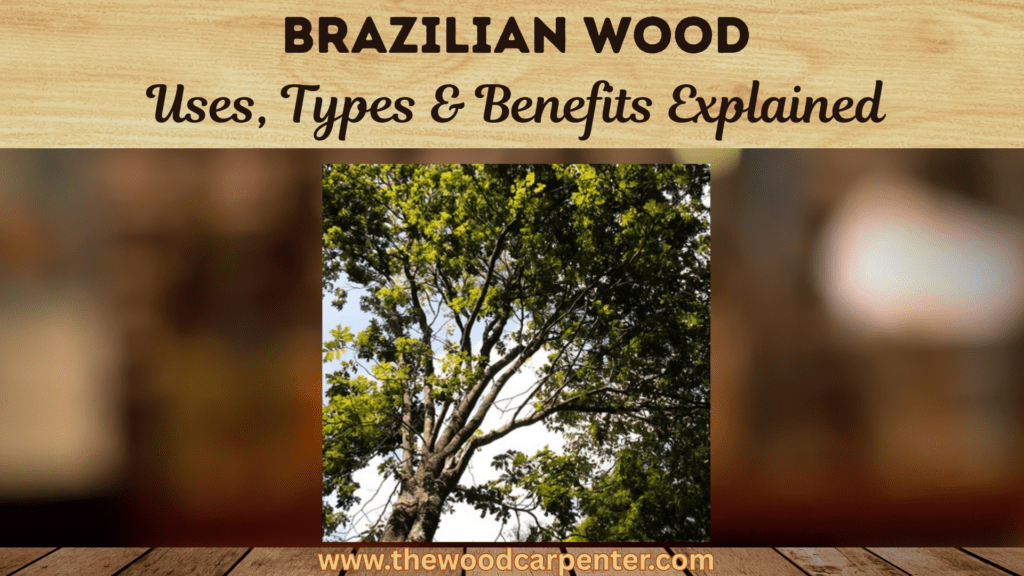
Introduction
Brazilian wood is known worldwide for its durability, strength, and stunning natural beauty. Found in the dense forests of Brazil, these woods are widely used in furniture making, construction, musical instruments, and even in spiritual and Vastu practices. In this article, we will explore various types of Brazilian wood, their benefits, uses, pricing, and answers to commonly asked questions.
What Is Brazilian Wood?
Brazilian wood refers to a variety of hardwood species found in Brazil, each with unique properties. Some of the most popular types include Ipe, Jatoba, Cumaru, and Brazilwood (Pau-Brasil). These woods are known for their exceptional strength, resistance to insects, and stunning grain patterns.
Best Varieties of Brazilian Wood
Ipe (Brazilian Walnut or Ironwood)
Ipe is arguably one of the most well known Brazilian hardwood, it is well reputed for its strength and durability. Ipe is usually Orange /brownish in colour, although can be a darker reddish brown as well in varying degrees – it is incredibly rot and insect resisting.
It is extremely hard (as an example, on the Janka scale of Hardness, it gets a 3680 rating) and is widely used in extreme wear applications such as exterior decking, flooring, lumber, and heavy-duty work surfaces. Ipe is the finest quality wood available and it comes from South America.Ipe is also known as Brazilian Walnut.
Jatoba (Brazilian Cherry)
Named for its beautiful reds and oranges that deepen as it ages; jatoba has ornamental appeal. It is a hard, long-lasting wood, resistant to decay and perfect for interior applications that need resistance to wear; such as flooring, kitchen cabinetry and high-impact furniture.
Jatoba is great for scratching and denting resistance as its hard and dense wood which is preferred for high-traffic as well as heavy-use domestic objects.
Cumaru (Brazilian Teak)
Cumaru is a high density wood, most comparable to Ipe. It is available in colors that range from red-brown to golden tan, adding warmth to furniture and flooring. Due to its high Janka hardness rating of 3540, and natural resistance to the elements, this is a favorite selection, whether used inside or outside. Cumaru is also environmentally friendly as it is taken from well-managed forests.
Garapa (Brazilian Oak)
Garapa is much lighter in color, ranging from a pale yellow to golden. Its janka hardness rating is lower than the aforementioned woods, but is still much higher than plenty domestic hardwoods such as cedar. Garapa is known for its long life and durability, as well as its resistance to rot and mold, even when left untreated.
Massaranduba (Brazilian Redwood)
Massaranduba has a dark cherry-red color and has a personality similar to Ipe, but is a little gentler. It can be an affordable and long-lasting decking and exterior wood treatment option that’s resistant to decay and insects.
Tigerwood
Tigerwood has a distinctive reddish-brown and dark stripes, and is favored for decorative use in cabinets, furniture, and flooring. It pairs hardness with undeniable good looks.
Uses of Brazilian Wood
Flooring and Decking
Brazilian hardwoods such as Ipe, Cumaru and Massaranduba are not only dense and durable, but are also resistant to decay, which makes them a very popular choice when it comes to decking and flooring. With their natural oils they protect themselves against moisture and insects so that they are optimal for outdoor usage and also for heavily frequented floors indoors.
Furniture Making
Brazilian woods are long sought for attractive and strong furniture, from exquisite cabinetry to sturdy tables. The range of colours and grain patterns enables designers to make a selection from which to create pieces that combine durability with unique, non-duplicable elegance.
Exterior Applications
Timbers douglas fir external cladding and garden landscaping timbers like Ipe (also known as brazilian walnut) and Garapa are in big demand. Impervious to weather and insects while providing long-lasting quality without the need for painting, sanding or refinishing.
Musical Instruments and Specialty Uses
Some Brazilian woods, Pau-Brasil among them, have been used historically for musical instrument bows because they have a favorable weight-to-stiffness ratio and are workable to form a bow.
Indoor Plants and Air Purification
Other than wood, Brazilian wood plants such as the Brazilian Lucky Wood (Dracaena fragrans) are a favorite indoor plant species that may purify the air and consequently brings wellness and positive energy to homes and offices.
Benefits of Brazilian Wood
Durability and Longevity
Brazilian hardwoods are the hardest woods on Earth, and they are some of the toughest flooring you can buy that will enhance the life of a product.
Inate immunity to Decay and pests
The high density of cells and the natural oils in Brazilian woods can discourage insects and fungi, which minimizes chemical treatment.
Aesthetic Appeal
Indian wood displays a broad array of colour, ranging from dark brown and red in Jatoba and Massaranduba to light yellow in Garapa, while the texture and grain have a kaleidoscopic beauty.
Sustainability and Eco-Friendliness
The hardwoods from Brazil are harvested from responsibly managed forests with a strict environmental commitment aimed at the preservation of biodiversity and protection of ecological balance.
Low Maintenance
Characteristics like natural resistance to rot also make Brazilian wood easier to maintain. For example, flooring and decking generally just requires cleaning, and occasional oiling to keep its looks and life.
Brazilian Wood vs. Other Hardwoods
| Feature | Brazilian Wood | Teak Wood | Oak Wood |
|---|---|---|---|
| Durability | High | Very High | Moderate |
| Water Resistance | Excellent | Excellent | Moderate |
| Pest Resistance | High | Very High | Low |
| Price | Moderate to High | Very High | Moderate |
| Uses | Flooring, furniture, musical instruments | Furniture, boats | Furniture, flooring |
FAQs About Brazilian Wood
1. What are the different types of Brazilian wood?
Ipe, Jatoba, Cumaru, Garapa and Massaranduba are the top species with their superior strength and beauty.
2. Why is Brazilian wood so hardy?
They are extremely heavy and have lots of natural oils to resist rot, insects and weather.
3. Is Brazilian wood good for outdoor use?
Yes, Ipe and Cumaru and other woods are fantastic for outdoor decking or siding or furniture.
4. Is Brazilian wood sustainable?
A great many come from responsibly managed forests certified by groups like the FSC.
5. What are the Brazilian wood aesthetic advantages?
They come in a variety of colors and have rich and lovely grain that fits into any room.
6. Is Brazilian wood less expensive than domestic wood?
Brazilian woods in most cases have a higher cost/benefit, are durable and looks better.
7. Is Brazilian wood easy to maintain.
Does it need an maintenance Its simple to maintain, just like clean and oil when you need.
8. Is it possible to grow the Brazilian fire wood in Doors?
Yes, Brazilian Lucky Wood plant grows indoors with indirect light and moderate watering.
9. What are the general care requirements for Brazilian Wood plants?
Plant your money tree in a well-drained growing medium, water sparingly, make sure it gets indirect sunlight, trim it regularly.
10. Are Brazilian wood plants resistant to pests?
Mostly yes, though you’ll want to keep an eye out for pests such as aphids; insecticidal soap can be useful for managing them.
Final Thoughts:
Brazilian Wood is not only beautiful, it’s made to last in numerous styles of both hardwood floors and quality decking materials that meet the most effective and versatile uses for your beautiful living and working space.
Whether it is being utilized as flooring, cabinetry, decking, or even for indoor air filtration via Brazilian wood plants, the durability, resistance, and visual appeal that it brings to the table make it a long-term investment in quality product.
With environmental friendliness becoming increasingly important around the world, hardwood from Brazilian forests adds eco-friendly appeal to performance, and is thus one of the best woods for demanding consumers and architects the world over.
This all–embracing overview explains why Brazilian wood is still the number one material for wood workers the world over – it is both strong and beautiful, as well as more environmentally friendly than one might think.

